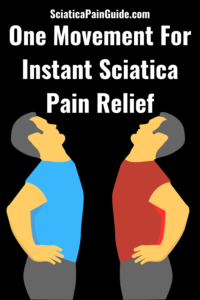One Movement For Instant Sciatica Pain Relief
Discover the power of one movement for instant sciatica pain relief. Dive into effective techniques that promise ease and improved mobility. Dive deep into a comprehensive guide that’s your key to a pain-free life. Oh, the notorious sciatica! If you’ve ever experienced that searing pain shooting down your leg, you know exactly what I’m diving into today. Sciatica pain is no joke – it’s that uninvited guest that barges into your life, disrupting your comfort, sleep, and daily activities. As someone who has wrestled with sciatica, I empathize with the struggle and understand how crucial finding relief becomes in maintaining sanity and quality of life.
Understanding Sciatica
Sciatica involves pain that radiates along the sciatic nerve, usually affecting one leg. It often results from nerve compression due to a herniated disk or bone spur in the spine.
Defining Sciatica
Sciatica, in its purest form, is pain that radiates along the path of the sciatic nerve, which branches from your lower back through your hips and buttocks and down each leg. Typically, it only affects one side of your body and can range from a mild nuisance to an unbearable agony that interferes with your day-to-day activities.
Common Causes of Sciatica
The sciatic pain shows up unannounced when the sciatic nerve gets pinched, often by a herniated disk in your spine or by an overgrowth of bone (bone spur) on your vertebrae. More rarely, it can be caused by a condition like diabetes or a situation such as sitting on a wallet for a prolonged period.
The Burden of Living with Sciatica Pain
Living with sciatica is akin to having an invisible ailment; it doesn’t manifest externally but has a massive internal impact. Imagine planning your day not around your tasks but around managing your pain. The burden isn’t merely physical; it seeps into your mental state, emotions, and social life.
Daily Challenges
Impact on Daily Activities
Every step can be a reminder of the pain, restricting physical actions and the joys of life, like playing with kids or going for a leisurely walk.
Mental and Emotional Strain
The persistent pain interrupts sleep, affects mood, and can lead to a cascade of frustrations and emotional exhaustion.
Finding the Ideal Movement for Instant Relief
The journey to discover that one movement that brings instant relief is marred with trial and error, exploring exercises, and deciphering what alleviates or exacerbates the pain.
Consideration of Various Exercises
Yoga Poses
From the gentle “Child’s Pose” to the strengthening “Bridge Pose”, yoga offers a plethora of options. Yet, it’s crucial to identify poses that don’t overstrain the sciatic nerve.
Stretching Exercises
Gentle stretches that target the lower back and hamstring can sometimes offer relief, but identifying the right stretch is key.
Strength Training
Strengthening the muscles supporting your spine may provide long-term benefits, yet caution is imperative to avoid further irritation.
The Golden Movement: A Deep Dive
After much exploration, I stumbled upon a movement – a simple yet profoundly effective stretch that provided instant relief!
A Step-by-Step Guide to One Movement for Instant Sciatica Pain Relief
Getting into Position
Begin by lying flat on your back, arms by your side, and legs fully extended.
The Movement Technique
Gently pull one knee towards your chest, holding it with both hands while keeping the other leg straight and grounded. Hold for 15-30 seconds, then switch.
What to Expect
The stretch might seem simplistic, but doing this daily, especially during flare-ups, can provide astonishing relief and be a preventative measure. When performing the sciatica-relieving movement, expect a gentle stretch along the lower back and hamstring, potentially providing immediate relief. Consistent practice may offer sustained benefits, including improved flexibility and reduced pain frequency. However, experiences may vary, and while some may find instant relief, others might require ongoing practice or alternative strategies, always ensuring comfort and safety in every movement.
The Golden Movement: A Deep Dive
The Golden Movement involves a simple, effective stretch, providing potential instant relief from sciatica pain by alleviating nerve tension and enhancing flexibility in the lumbar and pelvic regions.
Beneficial Aspects
The beneficial aspects of incorporating a targeted movement for sciatica pain are multifaceted. Not only does it potentially offer instant pain relief, but consistent practice also promotes spinal health, enhances flexibility, and improves overall mobility. Specifically, the elongation and gentle engagement of the sciatic nerve facilitate reduced inflammation and tension. Furthermore, the movement supports better posture, indirectly aiding in minimizing future pain episodes and contributing to a holistic approach toward managing sciatica effectively and sustainably.
Precautions and Expert Advice
Despite the effectiveness of this movement, it’s paramount to tread cautiously and recognize that our bodies are unique requiring personalized care.
When to Perform and When to Avoid
Choosing when to perform and when to avoid exercises for sciatica is vital for managing pain effectively. Engage in the movement during pain-free periods to maintain mobility and prevent future flare-ups. Opt for consistent, daily practice, especially when dealing with chronic conditions, to ensure sustained benefits. Conversely, avoid the exercise during acute pain episodes or if it induces discomfort beyond a mild stretch sensation. Always consult healthcare professionals before initiating any new movement practice to ensure safety, efficacy, and alignment with your specific sciatica management needs and overall health condition.
Conclusion: A Pain-Free Journey and Final Words
Embarking on a quest for a pain-free life amidst sciatica presents both challenges and revelations. Recognizing that a seemingly simple stretch can unveil a path to relief underscores the power of persistence and mindful exploration. The journey doesn’t conclude with discovering relief but continues as we embrace consistent practice, continuous learning, and an adaptable approach to managing our well-being. Through shared experiences and knowledge, we form a collective strength, navigating the complexities of sciatica together. Thus, we move forward, empowered, enlightened, and ever-resilient against the ebbs and flows of pain toward sustained serenity and vitality.
Please note that this article should not replace professional medical advice. Consult a healthcare professional for an accurate diagnosis and tailored treatment plan.
Frequently Asked Questions (FAQs)
Can one movement truly provide instant relief for sciatica?
Yes, one movement can truly provide instant relief for sciatica for some individuals by easing nerve compression and improving flexibility. However, effectiveness varies from person to person, and it’s imperative to approach every new movement with caution. Ensure you adopt correct techniques, seek professional guidance, and remain mindful of your body’s responses to achieve potential benefits.
Is it safe to exercise with sciatica?
Exercising with sciatica can be safe and beneficial when done correctly, emphasizing pain-free movements and prioritizing exercises that alleviate, rather than exacerbate, symptoms. Always consult a healthcare professional or physical therapist before starting any exercise regimen to ensure safety and efficacy, and adapt exercises as needed based on their recommendations and your body’s responses.
How often should I perform the movement for optimal benefit?
Perform the sciatica-relieving movement daily for optimal benefit, gradually increasing repetitions as comfort allows. Consistency is key to maximizing impact, but always prioritize pain-free execution and listen to your body’s signals. Adapt frequency and intensity according to personal response and consult a professional for a tailored exercise regimen.
What other interventions should be considered alongside this movement?
Complementing this movement with a holistic approach involving appropriate exercises, ergonomic adaptations, pain management strategies, and professional health advice will pave the path towards comprehensive sciatica management.
Should I consult a professional before trying new movements for sciatica?
Always consult a professional before trying new movements for sciatica. Healthcare experts or physical therapists can guide you towards safe, effective exercises and ensure you avoid movements that might exacerbate your condition. Tailored advice protects you from potential injuries and directs your path towards optimal, pain-relieving physical activity.
Extra FAQs Related to One Movement for Instant Sciatica Pain Relief
How to get rid of sciatica pain permanently?
Achieving permanent relief from sciatica pain typically involves combining consistent physical therapy exercises, maintaining proper posture, and possibly undergoing targeted treatments or surgeries. Always consult a healthcare professional for a personalized strategy, encompassing exercises, lifestyle adjustments, and possibly medical interventions, to permanently manage and potentially eradicate sciatica pain.
Is it better to rest or keep moving with sciatica?
Engage in gentle movements and avoid long periods of rest with sciatica. Continuous activity within comfort limits promotes blood flow and healing. However, prioritize pain-free motions and consult healthcare professionals to devise a balanced, therapeutic activity plan, ensuring you move safely without aggravating the sciatic nerve.
How to relieve sciatica pain in bed?
To relieve sciatica pain in bed, prioritize maintaining a supportive sleeping position. Place a pillow between your knees if you sleep on your side or under your knees if you lie on your back. Choose a medium-firm mattress and consider utilizing a lumbar roll for additional lower-back support.
Should I push myself to walk with sciatica?
Engage in walking with sciatica mindfully, paying close attention to pain signals. While moderate walking can enhance circulation and promote healing, pushing through severe pain can be detrimental. Tailor the duration and intensity according to comfort and ensure to prioritize a correct, upright walking posture to avoid exacerbating symptoms.
What relaxes the sciatic nerve?
Gentle stretching exercises, like the knee-to-chest pull or the seated spinal stretch, can relax the sciatic nerve. Applying a hot or cold pack, engaging in low-impact activities such as walking or swimming, and utilizing pain-relief modalities like massage or acupuncture also contribute to soothing the sciatic nerve effectively.





